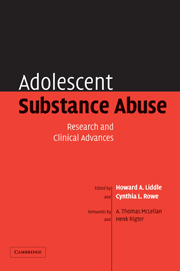Book contents
- Frontmatter
- Contents
- List of contributors
- Forewords
- Acknowledgements
- List of abbreviations
- 1 Treating adolescent substance abuse: state of the science
- Part I Theoretical, empirical, and methodological foundations for research in adolescent substance abuse treatment
- 2 The developmental context for adolescent substance abuse intervention
- 3 Recent methodological and statistical advances: a latent variable growth modeling framework
- 4 Clinical course of youth following treatment for alcohol and drug problems
- 5 Cannabis Youth Treatment intervention: preliminary findings and implications
- Part II Practice and policy trends in treatment for adolescent substance abuse
- Part III Comprehensive assessment and integrative treatment planning with adolescent substance abusers
- Part IV Empirically based interventions for adolescent substance abuse: research and practical implications
- Part V Culturally based treatment development for adolescent substance abusers
- Part VI Building the future
- Index
- References
3 - Recent methodological and statistical advances: a latent variable growth modeling framework
from Part I - Theoretical, empirical, and methodological foundations for research in adolescent substance abuse treatment
Published online by Cambridge University Press: 26 August 2009
- Frontmatter
- Contents
- List of contributors
- Forewords
- Acknowledgements
- List of abbreviations
- 1 Treating adolescent substance abuse: state of the science
- Part I Theoretical, empirical, and methodological foundations for research in adolescent substance abuse treatment
- 2 The developmental context for adolescent substance abuse intervention
- 3 Recent methodological and statistical advances: a latent variable growth modeling framework
- 4 Clinical course of youth following treatment for alcohol and drug problems
- 5 Cannabis Youth Treatment intervention: preliminary findings and implications
- Part II Practice and policy trends in treatment for adolescent substance abuse
- Part III Comprehensive assessment and integrative treatment planning with adolescent substance abusers
- Part IV Empirically based interventions for adolescent substance abuse: research and practical implications
- Part V Culturally based treatment development for adolescent substance abusers
- Part VI Building the future
- Index
- References
Summary
Since the late 1970s, we have witnessed a gradual increase in the complexity of theoretical models that attempt to explain development in substance use and related problem behaviors (e.g., Akers & Cochran, 1985; Patterson et al., 1992; Sampson, 1988, 1992; Sampson & Laub, 1990). The field has moved away from an emphasis on cross-sectional person-centered data toward a wider examination of the developmental nature of behavior over time, person–environment interactions, and the social context as an interactive, interdependent network that exerts influence on all its members (e.g., Conger, 1997). This social–contextual framework for studying change necessitates a broad conceptual approach that is not subsumed by any single theory. The conceptual movement to examine substance use behavior from both a developmental and contextual perspective parallels recent methodological and statistical advances in the analysis of change. The search for the best methods to address complex issues in behavior change has been a persistent theme of recent developmental research (e.g., Collins & Horn, 1991; Collins & Sayer, 2001; Duncan et al., 1999; Gottman, 1995) and has prompted a shift in analytic strategies. Rather than focusing on homogeneous populations and inter-individual variability, analysts are turning to new methods to explore both inter- and intra-individual variability and heterogeneity in growth trajectories of substance use.
Historically, research into prevention intervention has included efficacy and effectiveness studies, both of which generally incorporate a longitudinal design to examine mediators and long-term effects.
Information
- Type
- Chapter
- Information
- Adolescent Substance AbuseResearch and Clinical Advances, pp. 52 - 78Publisher: Cambridge University PressPrint publication year: 2006
